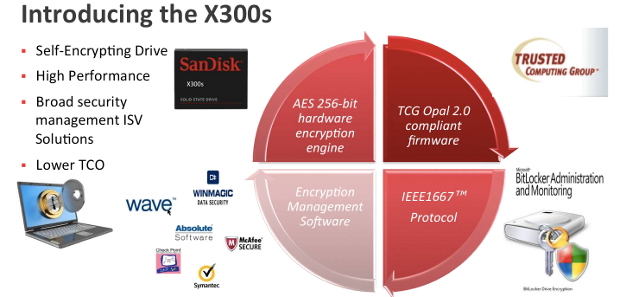SanDisk Corporation, a world-leading producer of flash storage devices, is announcing the X300s self-encrypting solid state drive (SSD). The X300s is designed with corporate users in mind, reflecting today’s increasingly risky corporate landscape.
Not all data breaches are the result of hacking into corporate systems, with a large percentage due to loss or theft of mobile devices; especially laptops. Less than 38% of corporations have an encryption policy in place, which could have thwarted many of these data breaches. The cost of such breaches can be quite heavy, including possible fines and damage to brand and/or corporate reputation.
SanDisk’s X300s self-encrypting SSD also has the added administrator benefit of the SanDisk SSD Dashboard, which is the companion software suite to the X300s. It is provided free of charge to SanDisk SSD customers, and features an all-new GUI and all-new performance and health monitoring tools.
The benefits of replacing HDDs with SSDs are magnified as solid state storage continues to evolve at a breath-taking pace. Consider this — Since 2000, network speeds have increased by some 400X, the PCIe bus interface speed has increased by 48X, CPUs are 30X faster, and DRAM is 14X faster. Yet HDDs have only seen a 1.2X performance increase since 2000. The performance gap between HDDs and SSDs continues to widen.
As virtualization and cloud computing continue to expand, HDDs will be left behind as they just are not capable of the IOPS needed, nor the low latency required by today’s high-performance applications. HDDs are not optimized to provide the best combination of capacity, performance and power. As total cost of ownership (TCO) becomes an increasingly important factor, SSDs continue to gain ground at a rapid pace.
The SanDisk X300s SSD features on-board 256bit AES hardware encryption, which is easily managed by either TCG Opal or Microsoft eDrive software. Hardware-based encryption suffers virtually no performance degradation, whereas software defined encryption can result in performance loss of nearly 25%.
The SanDisk X300s is assembled with SanDisk 1Ynm MLC NAND, and will be offered in capacities ranging from 64GB to 1TB. Sequential read and write speeds are stated as 520MB/s and 460MB/s, respectively. Random 4K read speeds are stated as 96,000 IOPS, with random 4K write speeds of 79,000 IOPS. The X300s is optimized for low queue depth performance. Mean Time Between Failures (MTBF) is stated as being up to 2,000,000 hours.
The X300s will be offered in both a 2.5″ x 7mm and M.2 x 2280 form factor. SanDisk anticipates the X300s to be available in May of 2014. Pricing has not yet been indicated.
 The SSD Review The Worlds Dedicated SSD Education and Review Resource |
The SSD Review The Worlds Dedicated SSD Education and Review Resource | 


Controller?
I’m guessing marvell.
I guess that too, I just wanted some official confirmation. A review between this and the Crucial M550, which focuses heavily on the encryption features & performance, would be pretty awesome!
There is no NDA on the controller but we will hve to wait for product release… I am laying 10-1 odds on Marvell
SanDisk is under NDA as far as controller specifics, but Benjamin is likely correct as to the manufacturer.
Definitely Marvell as SanDisk just dropped $10Mil to license Marvell’s controller IP,